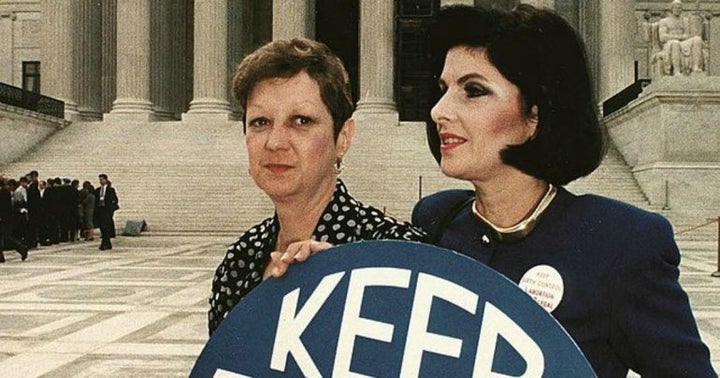
Norma McCorvey and Gloria Allred, 1990
On February 18, Norma McCorvey, the Roe in Roe v. Wade, died at 69. She was an American tragedy. Used by forces on all sides of the abortion debate, her life was filled with disappointment and chaos. Peace probably only came to her in death.
Though she was the person behind the anonymous Roe, she had almost nothing to do with the outcome in Roe v. Wade. She did not have an abortion—for her lawyers, considering a legal concept called standing, believed it was preferable to have her pregnant when the case was filed, and even though she prevailed on the merits in the trial court in Texas, the court did not enjoin the anti-abortion statute pending the appeal. She had already given birth by the time the case was finally affirmed in the Supreme Court.
So ironies of ironies, the woman most publicly associated with a woman’s right to an abortion never had one.
What is more, McCorvey’s personal story had little impact on the thinking of the justices of the United States Supreme Court who fashioned the relief in Roe v. Wade. They did not invent the “viability” standard to help in cases like hers—McCorvey’s particular profile was not the one with which they wrestled when they compromised on the result.
Before going behind the scenes at the Supreme Court, a brief reminder of the sad outlines of Norma McCorvey’s tempestuous life. Her home situation growing up was troubled, mainly by a mother who was physically and mentally abusive. “She called me stupid, and an idiot, and when she was angry, which was just about every time she saw me, she smacked me so hard my head hurt,” she wrote in her 1994 autobiography, I Am Roe, My Life, Roe v. Wade, and Freedom of Choice.
She bounced from reform school to reform school and by sixteen had married a 21-year-old hustler named Woody McCorvey on impulse. But when she quickly became pregnant, Woody McCorvey beat her and she left him, returning to her mother’s home. Even there, she was double-crossed by her mother, who adopted McCorvey’s daughter under false pretenses after finding out that McCorvey had lesbian tendencies.
Before she was twenty, she was again pregnant from a one-week affair. This time, McCorvey decided to give up the baby for adoption even before the birth.
She lived on the streets, bartended in gay bars, sold drugs, and eventually found work in a carnival. She had many sexual experiences, with men and women, and fell easily into drugs, including pot, acid and mescaline. She was an outsider, a rebel.
When she was twenty-one, she was pregnant for the third time. This time an attorney who specialized in adoptions led her to Sarah Weddington and Linda Coffee, two young lawyers looking for a plaintiff to challenge the century old Texas abortion statute. McCorvey lied to the lawyers, telling them that the pregnancy was the result of a rape, hoping this would increase her chances of having an abortion.
McCorvey never saw the inside of a courtroom. Her case was presented, as lawyers say, “on the papers.” She signed a simple affidavit, as did a doctor. That was it—the entirety of the record except for “friends of the court” briefs. The three-judge panel, including the woman who swore-in LBJ on the plane in Texas following the Kennedy assassination (Judge Sarah Hughes), heard no testimony, from McCorvey or from experts. The case was argued for a couple of hours; McCorvey was not present.
The case proceeded directly to the Supreme Court, a quirk of procedure not available today. When the justices read the briefs and heard oral argument in December 1971, McCorvey was as invisible as she was anonymous. She did not come to the Supreme Court to hear 27-year-old Sarah Weddington argue on her behalf.
In the first draft of his opinion in Roe v Wade, Justice Harry Blackmun spent three sentences on “Jane Roe,” the pseudonym for McCorvey. Her story was not recited. She was simply described as a single woman who resided in Dallas County, Texas and that she was “unmarried and pregnant,” had no money, and wished to terminate her pregnancy.
The case was set for re-argument in October 1972 as two new justices joined the Court (Powell and Rehnquist) after the first oral argument. McCorvey had already given up her “Roe” baby for adoption and once again she was not present for the proceedings in the Supreme Court.
In subsequent drafts, McCorvey again was treated summarily—she was simply an unmarried woman who had been pregnant and wanted a safe abortion and could not afford to travel to get one. The Justices were unconcerned with her life experiences or her reasons for seeking an abortion. The rights of the father are nowhere mentioned (it is not clear from all her writings that McCorvey knew who the father was).
The problem that engaged the Court was not McCorvey but other hypothetical women who would be impacted by the Court’s decision. The origin of this argument behind the scenes at the Court was the very question of when life begins.
In Justice Blackmun’s first draft of the Roe decisions (there was a companion case out of Georgia called Doe v Bolton), Blackmun held that a woman has a Constitutional right to privacy that protects her decision to have an abortion, but that the right is not unfettered. States, he wrote, had the right to limit abortions on behalf of fetal life—but the Court had not reached the point of understanding to say when the that line could be drawn.
In subsequent drafts, Blackmun suggested drawing the line after the first trimester. This was problematic to some of the clerks on the Court who felt that women who were young, inexperienced, or too afraid to tell boyfriends, spouses or family, would effectively lose the right to decide to abort if the cutoff was at the end of the first three months of a pregnancy.
As Justice Lewis Powell’s law clerk at the time, Larry Hammond, wrote: “For many poor, or frightened, or uneducated, or unsophisticated girls the decision to seek help may not occur during the first 12 weeks. The girl might be simply hoping against hope that she is not pregnant but is just missing periods. Or she might know perfectly well that she is pregnant but be unwilling to make the decision—unwilling to tell her parents or boyfriend.”
These hypothetical plaintiffs had little to no connection to McCorvey or her story. She was on a third pregnancy, well aware early on that she was pregnant, and she was under no inhibition in letting others know she was once again pregnant and wanted to end it.
The compromise decision of the Court was to use “viability” as the line after which a state might limit the right to an abortion based on the compelling interest of fetal life. This took the marker from the end of the third month to the end of the sixth month.
No one had argued viability. It was developed internally at the Court to address the situation of women who were not like Norma McCorvey.
The movement of that line, without argument or evidence, is one of the reasons Roe v. Wade has been attacked over time. It arguably sparked the rise of the Religious Right and indeed can be seen as the genesis of our current government of “no compromise.” Political enemies have become evil, not just wrongheaded. And compromise with evil people is a nonstarter.
But viability remains the standard forty years later. And now the woman who was Roe is dead. She jumped the fence to the pro-life movement in 1995, but even that commitment seemed insincere. With Norma McCorvey, nothing was constant other than her own personal pain and trauma.
In the end, she was a tool manipulated by both sides in the contest over a woman’s right to make her own choice in this most personal decision.
Her passing reminds us anew of the controversy that will not go away. President Trump pledged to appoint justices who will overturn Roe v. Wade. Given the ages of the sitting justices, he could achieve the result. And likely, whoever is the named plaintiff will be like McCorvey—someone lost in the storm.
James D. Robenalt, author of January 1973, Watergate, Roe v. Wade, Vietnam, and the Month That Changed America Forever. Robenalt interviewed Larry Hammond, Justice Lewis Powell’s law clerk at the time of Roe v. Wade, for untold story behind the decision.
